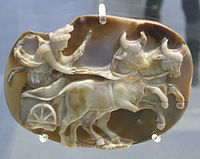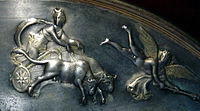Luna (goddess)
| Luna | |
|---|---|
Goddess of the Moon | |
Meh₁not |
In
In
Luna's Greek counterpart was Selene. In Roman art and literature, myths of Selene are adapted under the name of Luna. The myth of Endymion, for instance, was a popular subject for Roman wall painting.[7]
Cult and temples

The Romans dated the
As Noctiluna ("Night-Shiner") Luna had a temple on the Palatine Hill, which Varro described as shining or glowing by night. Nothing else is known about the temple, and it is unclear what Varro meant.[17]
Juno as Moon goddess
The
Chariot of the Moon
Luna is often depicted driving a two-yoke chariot called a biga, drawn by horses or oxen. In Roman art, the charioteer Luna is regularly paired with the Sun driving a four-horse chariot (quadriga).
Isidore of Seville explains that the quadriga represents the sun's course through the four seasons, while the biga represents the Moon, "because it travels on a twin course with the sun, or because it is visible both by day and by night—for they yoke together one black horse and one white."[21]
Luna in her biga was an element of
A biga of oxen was also driven by
Gallery
-
Bronze lamp of Luna and her ox-drawn chariot (1st century AD)
-
Statuette of Luna from theMâcon treasure(AD 150–220)
-
sardonyx cameo(AD 193–217)
-
Polychrome tauroctony relief, with Luna driving her ox-drawn biga (right), and the Sun his four-horse chariot (late 3rd century)
-
Ox-drawn biga of Luna on theParabiago plate(2nd–5th century AD)
See also
References
- ISBN 978-0-19-509539-5. Retrieved 4 February 2008.
- ^ C.M.C. Green, Roman Religion and the Cult of Diana at Aricia (Cambridge University Press, 2007), p. 73.
- ^ Horace, Carmen Saeculare, lines 33–36.
- ^ Varro, frg. 23 (Cardauns) = Tertullian, Ad nationes 2.2.14–2-; Attilio Mastrocinque, "Creating One's Own Religion: Intellectual Choices," in A Companion to Roman Religion, p. 383.
- ^ Jörg Rüpke, Religion of the Romans, p. 133.
- ^ William Van Andringa, "Religion and the Integration of Cities in the Empire in the Second Century AD: The Creation of a Common Religious Language," in A Companion to Roman Religion (Blackwell, 2007), p. 94.
- ^ Annemarie Kaufmann-Heinimann, "Religion in the House", in A Companion to Roman Religion, p. 188.
- Varro, De re rustica 1.1.4–6.
- ^ Vergil, Georgics 1.5–25.
- De Civitate Dei7.2.
- ^ Varro, De lingua latina 5.74; Dionysius of Halicarnassus 2.50.3.
- ^ Orosius 5.12.3–10; De Vir. Ill. 65; Lawrence Richardson, A New Topographical Dictionary of Ancient Rome (Johns Hopkins University Press, 1992), p. 238.
- ^ Ovid, Fasti 3.883–84; Richardson, A New Topographical Dictionary, p. 238.
- ^ Livy 40.2.2; Richardson, A New Topographical Dictionary, p. 238.
- ^ Appian, Bellum Civile 1.78.
- ^ Tacitus, Annales 15.41; Richardson, A New Topographical Dictionary, p. 238.
- ^ Varro, De lingua latina 5.68; Richardson, A New Topographical Dictionary, p. 238.
- ^ Green, Roman Religion and the Cult of Diana, p. 73.
- ^ Varro, De lingua latina 6.27.
- ^ Green, Roman Religion and the Cult of Diana, p. 73.
- ^ Isidore, Etymologies 18.26, as translated by Stephen A. Barney et al., The Etymologies of Isidore of Seville (Cambridge University Press, 2006), p. 368 online.
- ^ M.J. Vermaseren, Mithraica I: The Mithraeum at S. Maria Capua Vetere (Brill, 1971), pp. 14–15; Plato, Phaedrus 246.
- ^ Prudentius, Contra Symmachum 733 (Migne); Friedrich Solmsen, "The Powers of Darkness in Prudentius' Contra Symmachum: A Study of His Poetic Imagination," Vigiliae Christianae 19.4 (1965), p. 248.
- Servius, note to Aeneid6.118.
- ^ Hesiod, Theogony 413f.
External links
![]() Media related to Luna (mythology) at Wikimedia Commons
Media related to Luna (mythology) at Wikimedia Commons







